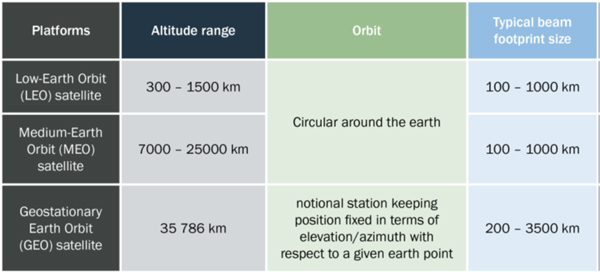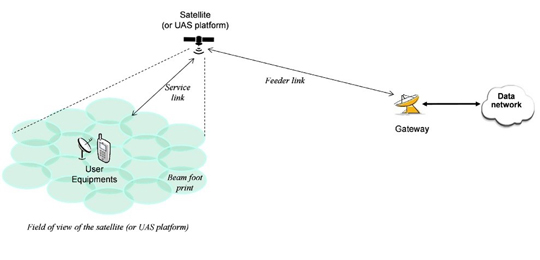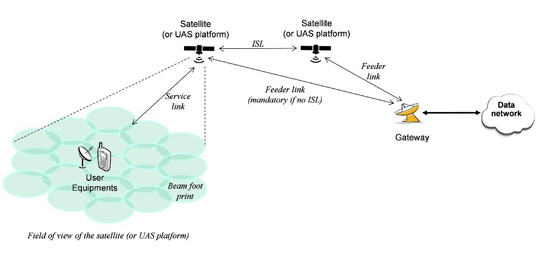(Sponsored content)
Introduction
Non-terrestrial networks (NTNs) are becoming increasingly more critical in providing wireless connectivity to areas where terrestrial networks cannot ensure coverage. Because NTNs operate above the earth’s surface, they can deliver seamless coverage to remote areas that lack traditional wireless access and increase overall resilience.
One use case in which NTNs are essential is public safety. Natural disasters or other acts can often make terrestrial networks inoperable. NTNs can help ensure first responder communications in those instances, aiding in protecting police, fire, EMS, and the general public.
NTNs have many technical challenges that must be overcome to fill those coverage gaps successfully. Examples include round-trip delays and cell mobility, which were addressed in 3GPP Release 17. Recognizing the obstacles associated with NTNs and implementing proper testing procedures will help ensure operation and improve wireless connectivity in critical areas and situations.
NTN Satellite Types
Typically, NTNs utilize satellites in low earth orbit (LEO), medium earth orbit (MEO), and geostationary orbit (GEO). High-altitude platform systems (HAPS) – balloons, airships, or powered fixed-wing aircraft that fly or float at altitudes of approximately 20 km – and drones are also used in specific networks.
Three satellite types (figure 1) are used in an NTN. As noted in the chart, latency is related to altitude. The higher the altitude, the longer the coverage. The more comprehensive the coverage, the slower the latency.

Figure 1: NTN satellite types and specifications.
Satellite-based NTNs consist of several elements. Gateways connect the NTN to a public data network. There are also feeder or radio links between a satellite gateway and the satellite itself. Finally, a service or radio link exists between the UE and the satellite.
3GPP has developed standards for NTNs to fill 5G coverage gaps and position them for future wireless technologies. The global standards body has also identified three use cases for satellite-based NTN:
Service Continuity – In areas where 5G services cannot be offered by terrestrial networks alone, NTNs are integrated to ensure service continuity.
Service Ubiquity – Use cases address unserved or under-served geographical areas where terrestrial networks may not be available. Public safety falls under this use case, as do rural settings.
Service Scalability – Applications in which the large coverage area of satellites is leveraged to multicast or broadcast content over a large area.
Architectures of NTNs
3GPP recommends two architectures to design and deploy satellite-based NTNs for 5G services:

Figure 2: Diagram of transparent payload NTN architecture.
Transparent Payload (figure 2) – In this architecture, the satellite serves as an analog RF repeater for the feeder and service links. RF filtering, frequency conversion, and amplification are done at the satellite. The result is that the waveform signal repeated by the payload is unchanged. For 5G connectivity, the satellite repeats the 5G NR-Uu radio interface from the feeder link to the service link.
Regenerative Payload (figure 3) – RF filtering, frequency conversion, amplification, demodulation/decoding, switch and/or routing, and coding/modulation are conducted at the satellite using this architecture. The satellite acts as a gNB or 5G base station in the sky. The signal from earth is regenerated, with the NR-Uu interface operating on the service link, while the N2 and N3 operate over a satellite radio interface on the feeder link.

Figure 3: Diagram of a regenerative payload NTN architecture.
Additionally, two possible satellite beams can be used to provide coverage. The application and location help determine which of the two works best for the specific need.
Moving-beam – A satellite with fixed beams yields a moving footprint on the earth’s ground. In this case, the beam moves relative to a fixed position on earth.
Fixed-beam – As the satellites orbit the earth, beams are adjusted so that they can continue to cover the same geographical area. In this scenario, the beams can be adjusted to cover that area, predicated on the satellite being above the horizon of said geographical area.
NTN Coverage Considerations
Their unique challenges must be addressed for NTNs to extend coverage and provide advantages in rural and emergency use cases. Recognizing those potential issues early in the design stage and before deployment will help ensure NTN operation. Below are the primary considerations.
Signal Strength Variation – An NTN satellite typically generates several elliptically shaped beams over a service area bounded by its field of view. The elliptical coverage and the fact that satellites move at high altitudes result in varied signal strength that must be accounted for when designing the NTN.
Dynamic Propagation Delays – Propagation is a function of speed and frequency. Satellite speed, the earth’s orbit, and the resulting constant change they create must be factored in to avoid propagation delays.
Mobile Cells – Unlike stationary terrestrial sites, an NTN cell site is constantly moving. The result is an exponential number of handoffs that increase the possibility of signals being dropped.
Doppler Shifts – NTNs have satellites that move as fast as 15,000 MPH. This creates a Doppler shift in frequency that varies depending on the satellite’s trajectory. The varying frequency shift needs to be compensated by the UE. Additionally, the distance the signal travels to reach the UE is much greater in an NTN, resulting in higher path loss.
Other considerations in the NTN that need to be evaluated are the various beams and cells and their associated coverage and internetworking with terrestrial networks. As with all networks, security is also a main concern. Overcoming all these challenges is dependent on accurately measuring frequency and timing.
Testing Hurdles Associated with NTNs
Because of the altitude of the satellites (or HAPS and drones) and the fact they serve as moving base stations, maintaining signal integrity and connectivity poses more significant challenges compared to terrestrial networks. Among the key factors that must be addressed are:
Scale – Assurances that the best possible Quality of Service (QoS) is achieved and maintained over large coverage areas must be established. That can only be done through comprehensive testing.
Performance – The reliability of NTNs to provide specified service despite the varying distances, speed, and mobility of the satellite and UE must be maintained. This can be done by emulating different UE mobility and fading profiles, in addition to fast-moving satellites. The significant Doppler shifts from fast-moving satellites, HAPS at 20 km altitude, and satellites at 600 km altitude must be considered.
Quality and Stability – Service quality and reliability for 5G NTN deployments in mission-critical applications are as high as for terrestrial public safety networks. In other words, there is no margin for error.
Multi-layer Communications – There is a myriad of connectivity issues with NTN. Satellite-to-satellite, satellite-to-ground, and satellite-to-airborne platform/aircraft can create challenges. Handovers between terrestrial and satellite links must be considered, as well. Additionally, high radio link capacity is needed to handle multi-path mesh networks. All these communications must be up to specification to ensure continuity of service.
Anritsu offers an extensive portfolio of test solutions to mitigate such problems. Products are designed for long-term spectrum monitoring and to address issues generated by equipment upgrades and interference from RF services operating in spectrum adjacent to satellite .
NTN: Critical to Public Safety
NTNs’ ability to provide reliable and resilient communications is why they are expected to play a growing and more important role in public safety. Here are the benefits of NTNs in ensuring first responder communications in mission-critical use cases:
Disaster Response and Emergency Communications – Natural disasters, such as earthquakes, hurricanes, or floods, adversely affect or destroy terrestrial communication infrastructure. Depending on the disaster, restoring the terrestrial network may take weeks or longer. NTNs are independent of ground-based infrastructure to maintain communication links, and first responders can coordinate efforts and share information to rescue civilians when necessary.
Remote Area Coverage – In isolated regions lacking cellular coverage or other communications infrastructure, NTNs can provide connectivity to emergency services. For this reason, first responders can better respond to incidents.
First Responder Communications – NTNs ensure that police, firefighters, and EMS can access reliable and continuous communication, even in challenging environments. This connectivity is essential for coordinating emergency response efforts and ensuring the safety of responders and the public.
Redundancy and Backup – If a terrestrial network fails or is overloaded during an emergency, NTNs can act as alternative communication channels, ensuring that critical public safety communications continue to transmit.
Cross-border and International Coordination – In emergencies where public safety efforts require coordination across borders or international boundaries, NTNs can serve as a unified platform for seamless communication and collaboration between various agencies and organizations.
Search and Rescue Operations – NTNs enable efficient communications between search teams, command centers, and distressed individuals in challenging terrains. The result is an increased likelihood of successful rescue missions.
Public Alerts and Notifications – NTNs can disseminate emergency alerts, warnings, and public notifications to a wide geographical area, ensuring that people receive critical information promptly during emergencies or disasters.
Continuity of Operations – When terrestrial infrastructure is damaged due to natural disasters, terrorist attacks, or other emergencies, NTNs allow government agencies, emergency services, and critical infrastructure providers to maintain operations and communications with minimal disruption.
Conclusion
NTNs have become a vital component of public safety and emergency response strategies. Their ability to provide reliable and resilient communications can make a significant difference in safeguarding lives and minimizing the impact of disasters and emergencies by maintaining vital communications with first responders.

